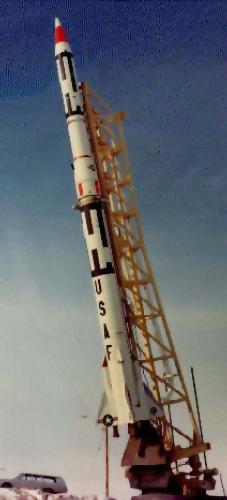Atlantic Research Athena
The Athena rocket was ordered by the U.S. Air Force from Atlantic Research Co. to test ICBM reentry vehicles (RVs) under the ABRES (Advanced Ballistic Reentry System) program. The first launch attempt of an Athena, which is reported as a successful flight by some sources and as a failure by others, occurred in February 1964. In any case, by the end of 1964 several Athenas had been successfully flown, and the ABRES program continued with an average rate of more than one launch per month.
 |
 | |
| Photos: White Sands Missile Range Museum | ||
| Athena | Athena H | |
The Athena was a multi-stage solid-fueled rocket. It could be flown with two, three or four solid-propellant rocket stages depending on the test requirement, but the typical (and probably most common) configuration was a four-stage vehicle with two additional solid-propellant boosters strapped to the first stage and ignited simultaneously with the latter. The first two stages lifted the rocket to an apogee between 200 and 300 km (125-185 miles). After that, the Athena pitched down and the remaining stages accelerated the RV towards the denser atmosphere to a speed of up to 6700 m/s (22000 fps). With a flight lasting only four minutes and going to a maximum distance of about 760 km (470 miles), the Athena could realistically simulate a 25 minute ICBM mission across 8000 km (5000 miles). The USAF launched more than 140 Athenas between 1964 and March 1977, testing reentry technology for the LGM-25 Titan, LGM-30 Minuteman, UGM-27 Polaris and UGM-73 Poseidon missiles. The vast majority of these tests were launched from Green River, Utah, and impacted at the Army's White Sands Missile Range.
The Athena H was used for the same purpose as the original Athena, but was of completely different configuration. It used a much larger and more powerful first stage with four strap-on boosters, but had only three main stages. The Air Force launched 18 Athena Hs between April 1971 and June 1974.
Note: The Athena test missile is completely unrelated to Lockheed Martin's modern Athena family of space launch vehicles.
Specifications
Note: Data given by several sources show slight variations. Figures given below may therefore be inaccurate!
Data for Athena, Athena H:
| Athena | Athena H | |
|---|---|---|
| Length | 15 m (50 ft) | 18 m (60 ft) |
| Diameter | 0.79 m (31 in) | 1.02 m (40 in) |
| Weight | 7300 kg (16000 lb) | 13600 kg (30000 lb) |
| Speed | 6700 m/s (22000 fps) | ? |
| Altitude | 300 km (185 miles) | > 200 km (125 miles) |
| Propulsion * | Booster: 2x Thiokol XM19 Recruit; 156 kN (35000 lb) each for 1.5 s 1st stage: Thiokol Castor; 235 kN (53000 lb) for 38 s 2nd stage: Thiokol TX-261-3 Pedro; 244 kN (55000 lb) for 11.3 s 3rd stage: Aerojet Alcor; 36 kN (8100 lb) for 30 s 4th stage: Hercules Alcyone; 34 kN (7600 lb) for 8 s |
Booster: 4x Thiokol XM19 Recruit; 156 kN (35000 lb) each for 1.5 s 1st stage: Thiokol Castor 4; 428 kN (96000 lb) for 54 s 2nd stage: ABL/Hercules X-259 Antares 2; 93 kN (21000 lb) for 6 s 3rd stage: Aerojet Alcor IA; 49 kN (11000 lb) for 23 s |
Main Sources
[1] Mark Wade: Encyclopedia Astronautica
[2] Jonathan McDowell: Launch Vehicles Database
[3] White Sands Missile Range Museum Website
Back to Directory of U.S. Military Rockets and Missiles, Appendix 4
Last Updated: 16 November 2004